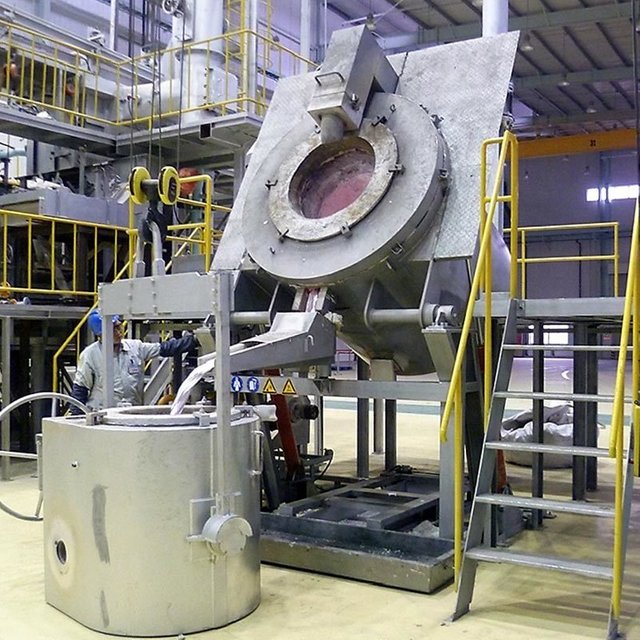aluminium melting machine
Aluminum melting machine is a kind of equipment specially designed for melting aluminum metal. It is widely used in many fields such as aluminum product manufacturing, aluminum alloy smelting, and recycling and reuse of scrap aluminum. The following is a detailed description of the equipment:

- Equipment Overview
The aluminum melting machine heats aluminum metal above its melting point to transform it from solid to liquid for subsequent casting, die casting and pouring processes. The equipment is usually equipped with an efficient heating system, precise temperature control device and a safe and reliable operating system to ensure the smooth progress of the melting process.
- Working Principle
The working principle of the aluminum melting machine is based on heat energy transfer. When the equipment is running, the heating system (such as resistance heating or induction heating) converts electrical energy or other energy into heat energy and transfers it to aluminum metal. As the heat continues to accumulate, the aluminum metal gradually heats up to its melting point and forms liquid aluminum in the molten pool. At this time, the temperature, time and quality of the melting process can be controlled by adjusting the power of the heating system and the stirring speed of the molten pool.
- Equipment Types
Aluminum melting machines can be divided into many types according to factors such as heating method, melting capacity and degree of automation. Common ones include:
- Resistance heating aluminum melting machine: Use the heat generated by current passing through resistance to heat aluminum metal.
- Induction heating aluminum melting machine: Generate eddy currents inside aluminum metal through the principle of electromagnetic induction, causing it to heat and melt itself.
- Automated aluminum melting production line: Integrates melting, stirring, degassing, slag removal, pouring and other functions to achieve automation and continuity of aluminum melting process.
- Equipment Features
- High efficiency and energy saving: Use advanced heating technology and optimized heat transfer design to improve energy utilization efficiency and reduce energy consumption.
- Precise temperature control: Equipped with high-precision temperature control device and advanced control system, it can achieve precise temperature control of the melting process.
- Safe and reliable: The equipment has a reasonable structural design and is made of high temperature resistant and corrosion resistant materials to ensure the stability and safety of the equipment during long-term operation.
- Easy to operate: Use automation and intelligent control technology to reduce operation difficulty and labor intensity and improve production efficiency.
- Application fields
Aluminum melting machines are widely used in aluminum product production, aluminum alloy smelting, and the recycling and reuse of waste aluminum. In aluminum product production, aluminum melting machines are key equipment for manufacturing aluminum alloy castings, die castings, and castings; in aluminum alloy smelting,
aluminum melting machines are used to melt aluminum ore or other aluminum raw materials and refine them into aluminum alloys; in the recycling of waste aluminum, aluminum melting machines are responsible for melting waste aluminum and recasting it into new products.
- Price range
The price of aluminum melting machines varies depending on factors such as brand, model, specification, material, and technology. Generally speaking, the price of aluminum melting machines for household or small industrial use is relatively low, while the price of large industrial aluminum melting production lines is higher.
Depending on market conditions, the price of aluminum melting machines may range from several thousand yuan to several hundred thousand yuan. The specific price needs to be determined based on actual demand and market supply.
In summary, aluminum melting machine is an important aluminum product production equipment with the advantages of high efficiency and energy saving, precise temperature control, safety and reliability, and easy operation. It is widely used in aluminum product production, aluminum alloy smelting, and recycling and reuse of waste aluminum materials.
Aluminum melting machines are designed to efficiently melt aluminum scrap or ingots to produce molten aluminum for casting or further processing. Here is an overview:
Types of aluminum melting machines:
- Electric induction furnace:
- Description: Utilizes electromagnetic induction to heat and melt aluminum, providing precise temperature control and high efficiency.
- Capacity: Varies from small units of a few hundred kilograms to large industrial furnaces of several tons.
- Gas-fired melting furnace:
- Description: Heats and melts aluminum via gas burners, typically used for larger batches with good thermal efficiency.
- Capacity: Typically suitable for medium to large operations.
- Crucible furnace:
- Description: A smaller, portable option where aluminum is melted in a crucible, suitable for small batches and lower capacities.
- Capacity: Typically between a few kilograms and a few hundred kilograms.
- Rotary furnace:
- Description: A rotary furnace that continuously melts aluminum, often used in aluminum scrap recycling operations.
- Capacity: Varies depending on model and application.
Main components:
- Furnace shell:
- External structure that provides insulation and protection.
- Heating system:
- Includes induction coils (for induction furnaces) or burners (for gas furnaces).
- Crucible or melting chamber:
- Part used to heat and melt the aluminum.
- Temperature control:
- Systems and sensors used to monitor and regulate the melting temperature.
- Casting mechanism:
- Equipment that safely transfers molten aluminum to molds or casting systems.
- Cooling system:
- Ensures that furnace components are kept at safe temperatures to prevent overheating.
Application areas:
Casting: Produces aluminum parts and products.
Recycling: Melts aluminum scrap for reuse in various applications.
Manufacturing: Provides molten aluminum for industrial processes.
Cost:
- Small units: $5,000 to $20,000
- Mid-sized models: $20,000 to $50,000
- Large industrial furnaces: $50,000 to $150,000 or more
Costs vary by capacity, features, and brand.